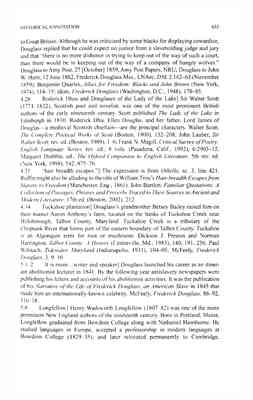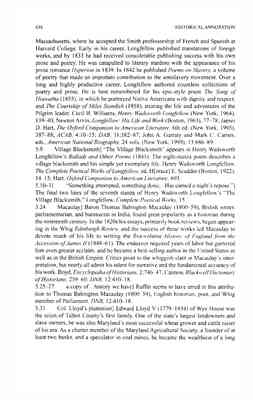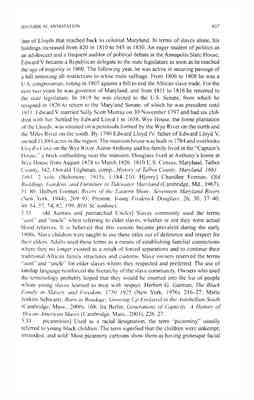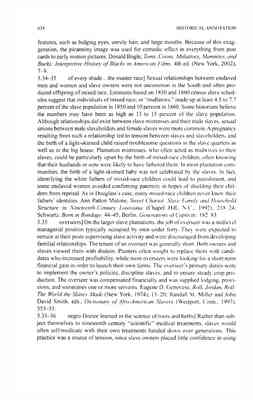Pages
6
634 HISTORICAL ANNOTATION
Civil War and the Preservation of Memory," Cultural Resource Management, 25:5- 9 (2002). 4.24-25 The odd proceedings. . .escape from slavery] Douglass's manumission was undertaken by friends and admirers whom he met during his first antislavery tour of the British Isles. In August 1846 Anna Richardson, a Quaker abolitionist from Newcastle-upon-Tyne, England, wrote Hugh Auld asking him whether Douglass's freedom had a price. Auld replied in October that he would manumit Douglass for £150 sterling. At that time, if not before, Anna Richardson together with her sister-inlaw, Ellen Richardson, took steps to raise the purchase money and made arrangements with American abolitionists, in particular Ellis Gray Loring of Boston, to handle the details of the negotiation. On 24 November 1846, Walter Lowrie of New York City, whom Loring had apparently deputed to carry on the negotiations, notified Hugh Auld that the £150 had arrived in New York and directed him to produce proof of legal ownership of Douglass. At about this time, Lowrie also engaged the services of J. Meredith, a prominent Baltimore attorney, to act as go-between and to take care that the papers were in order. Less than a week later Thomas Auld filed a bill of sale in Talbot County signifying the transfer of Douglass to Hugh Auld, and on 5 December 1846, Hugh Auld filed Douglass's manumission papers in Baltimore County. Exactly one week afterward the transaction was consummated, with Hugh Auld handing over to Lowrie via Meredith a copy of the bill of sale from Thomas Auld, a deed of manumission for Douglass, and a receipt showing he had received $711.66 for Douglass's freedom. All these papers were placed in Douglass's hands shortly thereafter. Douglass to the Editor, Belfast Protestant Journal, in Lib., 28 August 1846; Talbot County Records, V.60, 35-36, 30 November 1846, MdTCH (a copy is found on reel 1, frames 637-39, FD Papers, DLC); Deed of Manumission for "'Frederick Bailey. otherwise called Frederick Douglass," 12 December 1846. Hugh Auld's Receipt of Payment, 12 December 1846, Walter Lowrie to Ellis Gray Loring, 15 December 1846, all on reel 1, frames 637-43, FD Papers, DLC; NASS, 11 November 1847; NS, 3 December 1847; Glasgow Christian News, 23 December 1847. 4.26 the John Brown raid...flight across the ocean] Douglass departed for England from Quebec City on 19 November 1859 under the threat of prosecution for "murder, robbery, and inciting to servile insurrection in the State of Virginia" in connection with John Brown's raid on Harpers Ferry. Douglass was lecturing in Philadelphia when the news reached him of Brown's first attack on 16 October 1859. Fearing that letters found on Brown might be used to incriminate him, Douglass fled from Pennsylvania, making a circuitous and unobtrusive trip back to Rochester, New York. If not for the action of John W. Hurn, an admiring telegraph operator who delayed transmission of the order for Douglass's arrest by three crucial hours, Douglass might not have evaded the sheriff in Philadelphia. In early November, Governor Henry A. Wise of Virginia requested federal help in apprehending Douglass, and federal officials did indeed visit Rochester, reportedly to seize Douglass. By that time, however, Douglass had fled to Canada and was making final preparations to sail
7
HISTORICAL ANNOTATION 635
to Great Britain. Although he was criticized by some blacks for displaying cowardice, Douglass replied that he could expect no justice from a slaveholding judge and jury and that "there is no more dishonor in trying to keep out of the way of such a court, than there would be in keeping out of the way of a company of hungry wolves." Douglass to Amy Post, 27 [October] 1859, Amy Post Papers, NRU; Douglass to John W. Hurn, 12 June 1882, Frederick Douglass Mss., LNArc; DM, 2:162-63 (November 1859); Benjamin Quarles, Allies for Freedom: Blacks and John Brown (New York, 1974), 114-15; idem, Frederick Douglass (Washington, D.C., 1948), 178-85. 4.28 Roderick Dhus and Douglases of the Lady of the Lake] Sir Walter Scott (1771-1832), Scottish poet and novelist, was one of the most prominent British authors of the early nineteenth century. Scott published The Lady of the Lake in Edinburgh in 1810. Roderick Dhu, Ellen Douglas, and her father, Lord James of Douglas--a medieval Scottish chieftain--are the principal characters. Walter Scott, The Complete Poetical Works of Scott (Boston, 1900), 152-208; John Lauber, Sir Walter Scott, rev. ed. (Boston, 1989, 1-6; Frank N. Magill, Critical Survey of Poetry: English Language Series, rev. ed., 8 vols. (Pasadena, Calif., 1992), 6:2903-12; Margaret Drabble, ed., The Oxford Companion to English Literature, 5th rev. ed. (New York, 1998), 542, 875-76. 4.31 "hair breadth escapes."] The expression is from Othello, sc. 3, line 421. Ruffin might also be alluding to the title of William Troy's Hair-breadth Escapes from Slavery to Freedom (Manchester, Eng., 1861). John Bartlett, Familiar Quotations: A Collection of Passages, Phrases and Proverbs Traced to Their Sources in Ancient and Modern Literature, 17th ed. (Boston, 2002), 212. 4.34 Tuckahoe plantation] Douglass's grandmother Betsey Bailey raised him on their master Aaron Anthony's farm, located on the banks of Tuckahoe Creek near Hillsborough, Talbot County, Maryland. Tuckahoe Creek is a tributary of the Choptank River that forms part of the eastern boundary of Talbot County. Tuckahoe is an Algonquin term for root or mushroom. Dickson J. Preston and Norman Harrington, Talbot County: A History (Centreville, Md., 1983), 140, 191, 256; Paul Wilstach, Tidewater Maryland (Indianapolis, 1931), 104-05; McFeely, Frederick Douglass, 3, 9-10. 5.1-2 It is more...writer and speaker] Douglass launched his career as an itinerant abolitionist lecturer in 1841. By the following year antislavery newspapers were publishing his letters and accounts of his abolitionist activities. It was the publication of his Narrative of the Life of Frederick Douglass, an American Slave in 1845 that made him an internationally-known celebrity. McFeely, Frederick Douglass, 86-92, 116-18. 5.8 Longfellow] Henry Wadsworth Longfellow (1807-82) was one of the more prominent New England authors of the nineteenth century. Born in Portland, Maine, Longfellow graduated from Bowdoin College along with Nathaniel Hawthorne. He studied languages in Europe, accepted a professorship in modern languages at Bowdoin College (1829-35 ), and later relocated permanently to Cambridge,
8
636 HISTORICAL ANNOTATION
Massachusetts, where he accepted the Smith professorship of French and Spanish at Harvard College. Early in his career, Longfellow published translations of foreign works, and by 1833 he had received considerable publishing success with his own prose and poetry. He was catapulted to literary stardom with the appearance of his prose romance Hyperion in 1839. In 1842 he published Poems on Slavery, a volume of poetry that made an important contribution to the antislavery movement. Over a long and highly productive career, Longfellow authored countless collections of poetry and prose. He is best remembered for his epic-style poem The Song of Hiawatha (1855), in which he portrayed Native Americans with dignity and respect; and The Courtship ol Miles Standish (1858), treating the life and adventures of the Pilgrim leader. Cecil B. Williams, Henry Wadsworth Longfellow (New York, 1964), 139-40; Newton Arvin, Longfellow: His Life and Work (Boston, 1963), 77-78; James D. Hart, The Oxford Companion to American Literature, 6th ed. (New York, 1995), 387-88; ACAB, 4:10-15; DAB, 11:382-87; John A. Garraty and Mark C. Carnes, eds., American National Biography, 24 vols. (New York, 1999), 13:886-89. 5.9 Village Blacksmith] "The Village Blacksmith" appears in Henry Wadsworth Longfellow's Ballads and Other Poems (1841). The eight-stanza poem describes a village blacksmith and his simple yet exemplary life. Henry Wadsworth Longfellow, The Complete Poetical Works of Longfellow; ed. H[orace] E. Scudder (Boston, 1922), 14-15; Hart, Oxford Companion to American Literature, 693. 5.10-11 "Something attempted, something done, Has earned a night's repose."] The final two lines of the seventh stanza of Henry Wadsworth Longfellow's "The Village Blacksmith." Longfellow, Complete Poetical Works, 15. 5.24 Macaulay] Baron Thomas Babington Macaulay (1800-59), British writer, parliamentarian, and bureaucrat in India, found great popularity as a historian during the nineteenth century. In the 1820s his essays, primarily book reviews, began appearing in the Whig Edinburgh Review, and the success of these works led Macaulay to devote much of his life to writing the five-volume History of England from the Accession of James II (1848-61). The endeavor required years of labor but garnered him even greater acclaim, and he became a best-selling author in the United States as well as in the British Empire. Critics point to the whiggish slant in Macaulay's interpretation, but nearly all admit his talent for narrative and the fundamental accuracy of his work. Boyd, Encyclopedia of Historians, 2:746-47; Cannon, Blackwell Dictionary of Historians, 259-60; DNB, 12:410-18. 5.25-27 a copy of...history we have] Ruffin seems to have erred in this attribution to Thomas Babington Macaulay (1800-59), English historian, poet, and Whig member of Parliament, DNB, 12:410-18. 5.31 Col. Lloyd's plantation] Edward Lloyd V (1779-1834) of Wye House was the scion of Talbot County's first family. One of the state's largest landowners and slave owners, he was also Maryland's most successful wheat grower and cattle raiser of his era. As a charter member of the Maryland Agricultural Society, a founder of at least two banks, and a speculator in coal mines, he became the wealthiest of a long
9
HISTORICAL ANNOTATION 637
line of Lloyds that reached back to colonial Maryland. In terms of slaves alone, his holdings increased from 420 in 1810 to 545 in 1830. An eager student of politics as an adolescent and a frequent auditor of political debate at the Annapolis State House, Edward V became a Republican delegate to the state legislature as soon as he reached the age of majority in 1800. The following year, he was active in securing passage of a bill removing all restrictions to white male suffrage. From 1806 to 1808 he was a U.S. congressman, voting in 1807 against a bill to end the African slave trade. For the next two years he was governor of Maryland, and from 1811 to 1816 he returned to the state legislature. In 1819 he was elected to the U.S. Senate, from which he resigned in 1826 to return to the Maryland Senate, of which he was president until 1831. Edward V married Sally Scott Murray on 30 November 1797 and had six children with her. Settled by Edward Lloyd I in 1658, Wye House, the home plantation of the Lloyds, was situated on a peninsula formed by the Wye River on the north and the Miles River on the south. By 1790 Edward Lloyd IV, father of Edward Lloyd V, owned 11,884 acres in the region. The mansion house was built in 1784 and overlooks Lloyd's Cove on the Wye River. Aaron Anthony and his family lived in the "Captain's House," a brick outbuilding near the mansion. Douglass lived at Anthony's home at Wye House from August 1824 to March 1826. 1810 U.S. Census, Maryland, Talbot County, 342; Oswald Tilghman, comp., History of Talbot County, Maryland, 16611861, 2 vols. (Baltimore, 1915), 1:184-210; H[enry] Chandlee Forman, Old Buildings, Gardens, and Furniture in Tidewater Maryland (Cambridge, Md., 1967), 51-80; Hulbert Footner, Rivers of the Eastern Shore: Seventeen Maryland Rivers (New York, 1944), 269-93; Preston, Young Fredrick Douglass, 26, 30, 37-40, 48-54, 57, 74, 82, 199; BDUSC (online). 5.33 old Aunties and patriarchial Uncles] Slaves commonly used the terms "aunt" and "uncle" when referring to elder slaves, whether or not they were actual blood relatives. It is believed that this custom became prevalent during the early 1800s. Slave children were taught to use these titles out of deference and respect for their elders. Adults used these terms as a means of establishing familial connections where they no longer existed as a result of forced separations and to continue their traditional African family structures and customs. Slave owners reserved the terms "aunt" and "uncle" for older slaves whom they respected and preferred. The use of kinship language reinforced the hierarchy of the slave community. Owners who used the terminology probably hoped that they would be inserted into the list of people whom young slaves learned to treat with respect. Herbert G. Gutman, The Black Family in Slavery and Freedom, 1750-1925 (New York, 1976), 216-27; Marie Jenkins Schwartz, Born in Bondage: Growing Up Enslaved in the Antebellum South (Cambridge, Mass., 2000), 168; Ira Berlin, Generations of Captivity: A History of African-American Slaves (Cambridge, Mass., 2003), 226-27. 5.33 picanninies] Used as a racial designation, the term "picanniny" usually referred to young black children. The term signified that the children were unkempt, immodest, and wild. Most picanniny cartoons show them as having grotesque facial
10
638 HISTORICAL ANNOTATION
features, such as bulging eyes, unruly hair, and large mouths. Because of this exaggeration, the picanniny image was used for comedic effect in everything from post cards to early motion pictures. Donald Bogle, Toms, Coons, Mulattoes, Mammies, and Bucks: Interpretive History of'Blacks in American Films, 4th ed. (New York, 2002), 7-9. 5.34-35 of every shade...the master race] Sexual relationships between enslaved men and women and slave owners were not uncommon in the South and often produced offspring of mixed race. Estimates based on 1850 and 1860 census slave schedules suggest that individuals of mixed race, or "mullatoes," made up at least 4.5 to 7.7 percent of the slave population in 1850 and 10 percent in 1860. Some historians believe the numbers may have been as high as 13 to 15 percent of the slave population. Although relationships did exist between slave mistresses and their male slaves, sexual unions between male slaveholders and female slaves were more common. A pregnancy resulting from such a relationship led to tension between slaves and slaveholders, and the birth of a light-skinned child raised troublesome questions in the slave quarters as well as in the big house. Plantation mistresses. who often acted as midwives to their slaves, could be particularly upset by the birth of mixed-race children, often knowing that their husbands or sons were likely to have fathered them. In most plantation communities, the birth of a light-skinned baby was not celebrated by the slaves. In fact, identifying the white fathers of mixed-race children could lead to punishment, and some enslaved women avoided confirming paternity in hopes of shielding their children from reprisal. As in Douglass's case, many mixed-race children never knew their fathers' identities. Ann Patton Malone, Sweet Chariot: Slave Family and Household Structure in Nineteenth-Century Louisiana (Chapel Hill, N.C., 1992), 218-24; Schwartz, Born in Bondage, 44-45; Berlin, Generations of Captivity, 182-83. 5.35 overseers] On the larger slave plantations, the job of overseer was a midlevel managerial position typically occupied by men under forty. They were expected to remain at their posts supervising slave activity and were discouraged from developing familial relationships. The tenure of an overseer was generally short. Both owners and slaves viewed them with disdain. Planters often sought to replace them with candidates who increased profitability, while most overseers were looking for a short-term financial gain in order to launch their own farms. The overseer's primary duties were to implement the owner's policies, discipline slaves, and to ensure steady crop production. The overseer was compensated financially and was supplied lodging, provisions, and sometimes one or more servants. Eugene D. Genovese, Roll, Jordan, Roll: The World the Slaves Made (New York, 1974), 13-20; Randall M. Miller and John David Smith, eds., Dictionary of Afro-American Slavery (Westport, Conn., 1997), 553-55. 5.35-36 negro Doctor learned in the science of roots and herbs] Rather than subject themselves to nineteenth-century "scientific" medical treatments, slaves would often self-medicate with their own treatments handed down over generations. This practice was a source of tension, since slave owners placed little confidence in using




